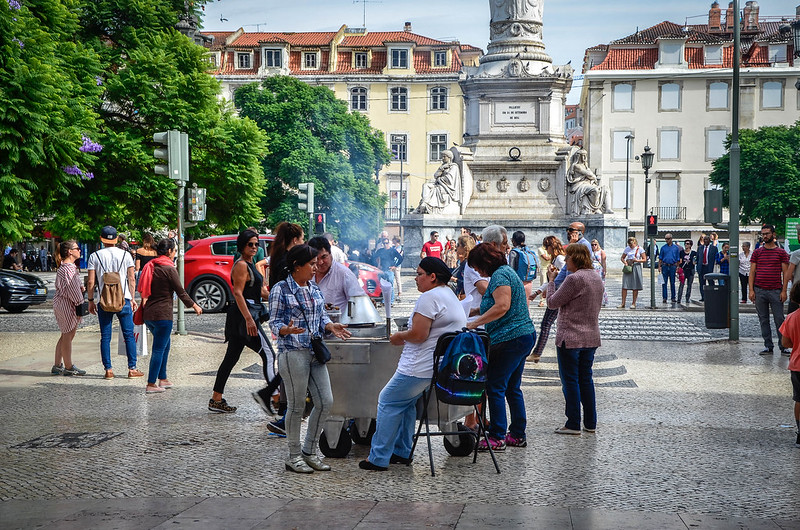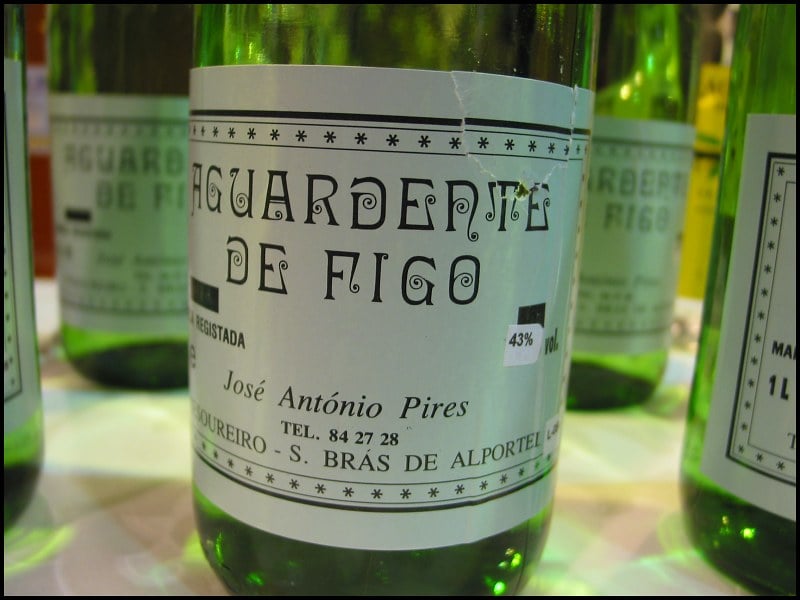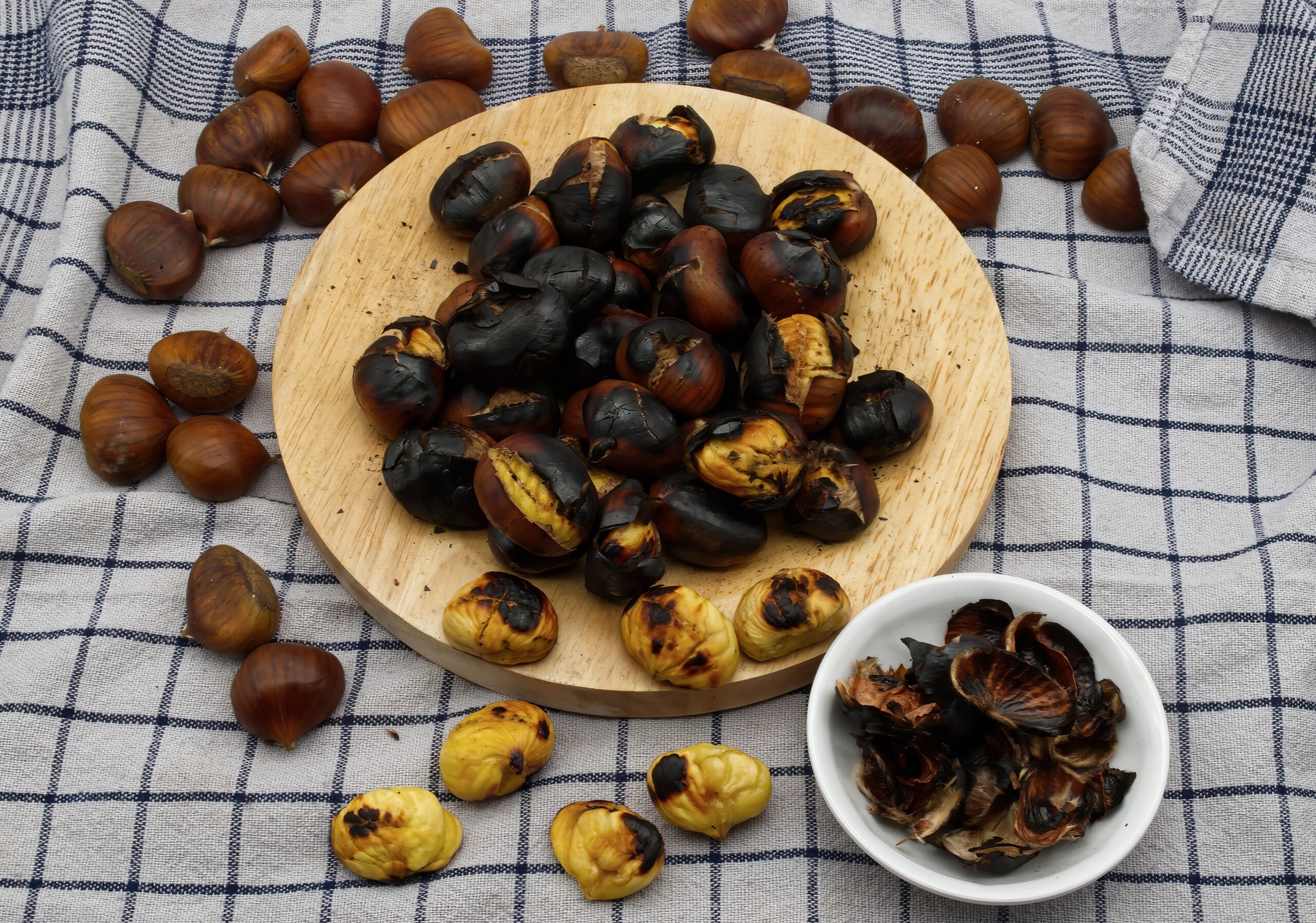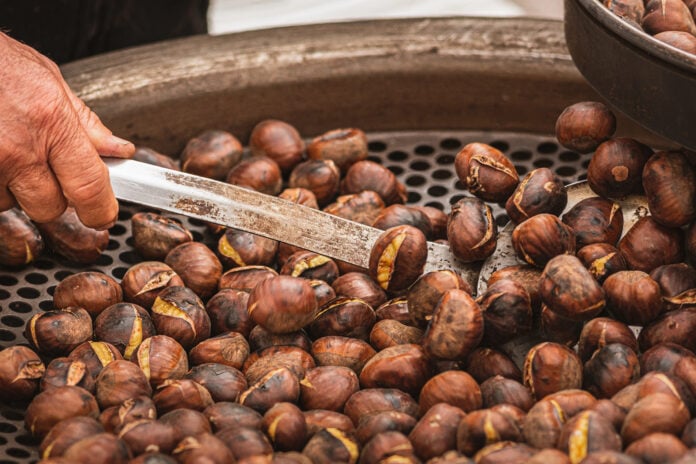It is that time of year again – time for one of my favorite holidays in Portugal but one that you may not have heard so much about – Dia de São Martinho – or St. Martin’s Day – on November 11. If you’re a fan of chestnuts, wine, or autumn, or all of the above, St. Martin’s Day just might become your favorite too.
What Do We Celebrate on St. Martin’s Day?
On November 11, St. Martin’s Day, Portuguese communities come together to celebrate harvest traditions and honor the kindness of Martin of Tours, a compassionate Roman soldier who, according to legend, cut his cloak in half to shield a freezing beggar. Legend has it that this act of kindness caused the weather to shift, as warm sunlight broke through the cold. In Portugal, this brief warm spell in early November is affectionately known as the “Verão de São Martinho” (St. Martin’s Summer).

Make Way for the Magusto
Besides celebrating St. Martin himself, communities also gather on St. Martin’s Day for what’s called the “Magusto,” an outdoor feast centered around roasted chestnuts. Alongside the chestnuts, friends and family light bonfires and tap the first wines of the year in honor of the harvest, produced from the summer’s grape harvest, and traditional drinks like “água-pé” (a mild wine derived from grape pomace) and “jeropiga” (a sweet blend of grape must and aguardente, Portuguese brandy). This part of St. Martin’s is one of my favorite parts of the holiday as, let’s be honest, who doesn’t love getting together, drinking wine, and enjoying the inviting scent of chestnuts roasting on an open fire? It’s like a Portuguese ode to the holiday spirit.
Chestnuts, Chestnuts, Everywhere!
On St. Martin’s Day, you may also notice more chestnut roasters (castanhas in Portuguese) standing on the corners and in front of shopping centers in Lisbon and Porto. Eating roasted chestnuts is an experience in itself. The shell is scored before roasting, allowing it to crack open slightly, making it easier to peel. As you pull away the shell and inner skin, the golden-brown nut inside is revealed – soft, slightly sweet, and with a dense texture. Chestnuts are best enjoyed slowly, piece by piece, making them an ideal snack for strolling through Portugal’s lively streets.

Chestnut cultivation in Portugal dates back to ancient times, and several regions have become renowned for their quality and abundance of chestnuts. In the northern areas, places like Trás-os-Montes, Bragança, and Viseu produce the “Castanha da Terra Fria,” a variety with a Protected Designation of Origin (DOP) status due to its distinct flavor and quality. The North’s cooler climate and fertile land make it one of the richest chestnut producing regions in Portugal.
In the Alentejo region, Marvão and Portalegre are home to the famous “Castanha Marvão-Portalegre.” Visiting this region in autumn offers a chance to taste these renowned chestnuts and also try hearty chestnut stews and soups, paired perfectly with Alentejo’s acclaimed wines.
Traditional Beverages to Try on St. Martin’s Day
As you enjoy your chestnuts on St. Martin’s Day, you can take the opportunity to try some of Portugal’s traditional autumn drinks. The strongest companion to chestnuts is aguardente, a potent brandy known as Portuguese “firewater,” distilled from wine and with an alcohol content of at least 40 percent – definitely not a drink for the faint of heart! Aguardente is best sipped slowly and provides a warming kick that’s especially welcome on cool fall evenings.

For something milder, jeropiga offers a sweeter flavor. Made by adding aguardente to grape must, this drink is less intense but equally delicious, pairing wonderfully with the earthy, nutty taste of chestnuts. Another classic option is água-pé. Produced by adding water to grape pomace, this beverage has a low alcohol content and a slightly acidic, fruity taste. Its pinkish hue and delicate flavor make it a refreshing contrast to the warmth of roasted chestnuts.
Chestnut Traditions Beyond the Magusto
Beyond the popular Magusto celebrations, the chestnut has also influenced Portuguese cuisine in creative ways as they are a versatile ingredient, and their warm, nutty flavor enhances both savory and sweet dishes.
They pair excellently with meats, especially game, where they add richness and texture. It’s common to see chestnuts cooked alongside pork or turkey, and they’re often combined with other autumn flavors like quince and sweet potatoes. For those with a sweet tooth, chestnuts make their way into confections, from cakes to puddings. The luxurious French-inspired treat of “marrons glacés” (candied chestnuts) also makes an appearance in Portuguese bakeries during the holiday season.

Over time, chefs and home cooks have experimented with chestnuts, breathing new life into traditional recipes. Chestnut flour, once a dietary staple, has seen a resurgence in modern Portuguese cooking, adding a rich, nutty flavor to bread and pastries. And in many regions, chestnuts are preserved by air-drying or freezing, which allow them to be enjoyed year-round.
In the northern interior, cities like Chaves and Bragança also embrace the chestnut’s cultural importance. With a history that spans centuries, chestnuts remain an important part of life here. Visitors will find chestnut-themed festivals, markets, and specialty foods that showcase the creativity and passion Portuguese people have for this cherished fruit.
Your Autumn Invitation to Portugal
I encourage you to celebrate the bounty of the season on St. Martin’s Day and join locals in savoring life’s simple pleasures. The smoke-filled streets, the warm glow of a Magusto bonfire, and the companionship of friends over chestnuts and wine create an unforgettable atmosphere that really captures the essence of Portuguese hospitality.
As you explore Portugal in the fall, you might want to bring a bit of this tradition into your own home. Here’s a classic and simple recipe for Castanhas Assadas (Roasted Chestnuts), a beloved Portuguese treat that’s perfect for cozy gatherings.
Recipe for Castanhas Assadas (Roasted Chestnuts)
Ingredients:
- Whole fresh chestnuts in the shell
- Sea salt
Instructions:
- Preheat your oven to 375°F (190°C).
- With a sharp knife, make a small slice in the top of each chestnut to prevent them from bursting as they roast.
- Rinse the chestnuts well under cold water.
- Arrange the chestnuts on a baking sheet and sprinkle with a generous amount of sea salt.
- Bake for about 40 minutes, until the shells begin to peel away slightly.
- Once removed from the oven, cover the hot chestnuts with a damp tea towel for a few minutes. This helps keep them moist and makes them easier to peel.
- Serve and enjoy with friends and family!

Should you find yourself in Portugal on November 11, be sure to raise a glass to Saint Martin and savor the season’s castanhas. As the Portuguese say, “É dia de São Martinho. Comem-se castanhas; prova-se o vinho!” (“It is St. Martin’s Day. We’ll eat chestnuts; we’ll taste the wine.”). Feliz Dia de São Martinho! – Happy Saint Martin’s Day!


